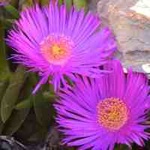Caprobrotus edulis
Cape fig, edible ice-plant Μπούζι

Aizoaceae - ice plant family Dicot.
Caprobrotus edulis
Cape fig, edible ice-plant Μπούζι

Aizoaceae - ice plant family Dicot.
An alien plant originating from the Cape area of S. Africa, Caprobrotus edulis has become a familiar sight along the coastline not only of the Mediterranean but much of Europe as far north as Great Britain with an outpost in the far north of Scotland. In Greece it has become naturalised inland as well as in coastal areas.
Although, with its brilliant purple flowers, it is attractive as a garden plant, it can be very invasive, forming dense mats which compete with native flora. Rapid spread is promoted by the black rat (Rattus rattus), which carries the seeds in its faeces.It is on the list of the 100 of the World's Worst Invasive Allien Spieces1 and the DAISY organisation (see below).
The fruits, known as sour figs are edible and can be made into jam. The juice which exudes from broken stems can be used as a soothing lotion for sunburn.



Alien invaders of Greece
Alien flora are plants introduced by man, they are divided into archaeophytes, plants introduced in antiquity and neophytes, those introduced in more recent times, that is since the 15th Century.
It is not always easy to differentiate ancient aliens from naturally occurring species in the Mediterranean basin, as man has been modifying his environment and introducing plants into this area for more than 5 millennia. Many ancient introductions from the Middle East and spread along with the agriculture and developing civilisation. They included important crop species: varieties of wheat, pulses, vegetables and fruit trees. The iconic Greek plant the pomegranate (Punica granatum) is an archaeophyte, which has become inextricably woven into Greek myths and legends.
More recent imports are mainly from the Americas and include 18 species of Amaranth, the wild greens known as vlita (βλήτα), which is on the summer menu of many tavernas.
Some neophytes, however have not been so well integrated into the ecosystem and some pose an environmental threat, which may become even more significant under the influence of climate change.
A state-of-the-art assessment of alien plants in Greece, listed 343 taxa;
49 archaeophytes and
294 neophytes.2
1. GLOBAL INVASIVE SPECIES DATABASE. Invasive Species Specilaist Group. www.issg.org
2. Arianoutsou.M. et al. The Alien Flora of Greece: taxonomy, life traits and habitat preferences. Biol. Invasions. 2010.




